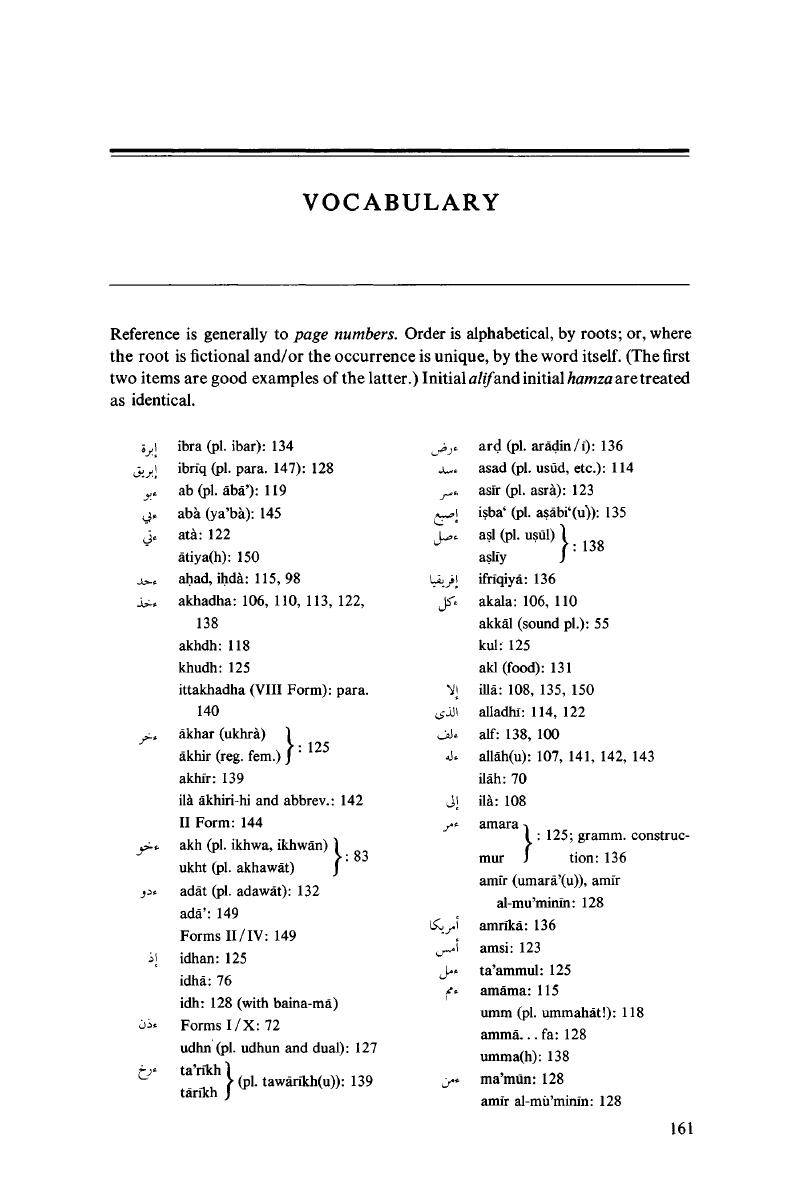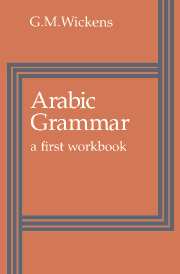Book contents
- Frontmatter
- ACKNOWLEDGEMENTS
- Contents
- Introduction
- 1 On learning languages in general
- 2 The nature of Arabic and the character of this course
- 3 Arabic script (13); The alphabet (14–17); Roots and patterns (18); Layout and punctuation (19)
- 4 The families B, J, D and R
- 5 The families S and thick S/T
- 6 The families ‘/F and K
- 7 The orphans and rejects
- 8 The vowels in Arabic: Short vowels (44–5); Diphthongs (46); Long vowels (47–8); Stress (49)
- 9 A final review of sounds and signs: Hamza (53); Madda (54); Wasla (55); Shadda (56); Bound-t (57); Names of consonants (58); Names of vowels (59)
- 10 Standard Verb in māḍī (62–7); Standard Noun (68–73)
- 11 Plurals (75–6); Sentence types: Verbal Sentence (77–8); Nominal Sentences (79–80); Nominal Absolutes (81); Summary of points (82)
- 12 Agreement (83–5); The Construct (86–8)
- 13 Standard Verb in muḍari' (91–3); Independent personal pronouns (94–5); Attached personal pronouns (96–8)
- 14 Sound Plurals (100–2); Dual nouns (103); Subjunctive and Jussive modifications of muḍāri' (104–6); Ambiguities in endings alif, -W, -Y, and -T (107)
- 15 Diptotes (109–10); Demonstratives (111–13); Imperatives (114–15); Participles and maṣdars
- 16 Derived Form II (121–2); Derived Form III (123–4); Derived Form IV (125–6)
- 17 Derived Form V (128–9); Derived Form VI (130–1); Wāw of Circumstance (132); Negatives (133–7)
- 18 Derived Form VII (139); Derived Form VIII (140); Derived Form X (141–2); Positive time-indicators (143)
- 19 Passives (145–6); Plurals of four-consonant nouns (147); Nouns of Time and Place (148); Nouns of Instrument (149)
- 20 Conditional and Quasi-Conditional Sentences (151–7); Colours and Defects (158); Elatives (159–60)
- 21 Minor peculiarities in verbs (162–5); Peculiar common nouns (166); Some essential distinctions (167)
- 22 Hollow Roots: Māḍī and muḍāri' of Form I (169–72)
- 23 Hollow Roots: Participles 1 (174); Maṣdar I (175); Forms II, III, V and VI (176)
- 24 Hollow Roots: Forms VII and VIII (178); Forms IV and X (179); Hollow Passives (180)
- 25 Weak Roots: General (182); Māḍī 1 (183); Muḍāri' I (184–5); Active Participles I (186); Passive Participles I (187); Miscellaneous noun-patterns (weak) I (188)
- 26 Weak Roots: Derived Forms in general (190); Form II (191); Form III (192); Form IV (193)
- 27 Weak Roots: Form V (195); Form VI (196); Form VII (197); Form VIII (198); Form X (199); Weak Passives (200)
- 28 Roots with multiple peculiarities (202–3); Cardinal numbers in combination (205); Government of cardinals (206); Polarity in cardinals (207); Cardinals 3–10 (208); 11–19 (209); 20 upwards (210); Ordinals, units and whole tens (211); Ordinals 11–19 (212); Fractions (213); Basic roots (215)
- Postscript
- Texts and analyses
- Vocabulary
Vocabulary
Published online by Cambridge University Press: 05 June 2012
- Frontmatter
- ACKNOWLEDGEMENTS
- Contents
- Introduction
- 1 On learning languages in general
- 2 The nature of Arabic and the character of this course
- 3 Arabic script (13); The alphabet (14–17); Roots and patterns (18); Layout and punctuation (19)
- 4 The families B, J, D and R
- 5 The families S and thick S/T
- 6 The families ‘/F and K
- 7 The orphans and rejects
- 8 The vowels in Arabic: Short vowels (44–5); Diphthongs (46); Long vowels (47–8); Stress (49)
- 9 A final review of sounds and signs: Hamza (53); Madda (54); Wasla (55); Shadda (56); Bound-t (57); Names of consonants (58); Names of vowels (59)
- 10 Standard Verb in māḍī (62–7); Standard Noun (68–73)
- 11 Plurals (75–6); Sentence types: Verbal Sentence (77–8); Nominal Sentences (79–80); Nominal Absolutes (81); Summary of points (82)
- 12 Agreement (83–5); The Construct (86–8)
- 13 Standard Verb in muḍari' (91–3); Independent personal pronouns (94–5); Attached personal pronouns (96–8)
- 14 Sound Plurals (100–2); Dual nouns (103); Subjunctive and Jussive modifications of muḍāri' (104–6); Ambiguities in endings alif, -W, -Y, and -T (107)
- 15 Diptotes (109–10); Demonstratives (111–13); Imperatives (114–15); Participles and maṣdars
- 16 Derived Form II (121–2); Derived Form III (123–4); Derived Form IV (125–6)
- 17 Derived Form V (128–9); Derived Form VI (130–1); Wāw of Circumstance (132); Negatives (133–7)
- 18 Derived Form VII (139); Derived Form VIII (140); Derived Form X (141–2); Positive time-indicators (143)
- 19 Passives (145–6); Plurals of four-consonant nouns (147); Nouns of Time and Place (148); Nouns of Instrument (149)
- 20 Conditional and Quasi-Conditional Sentences (151–7); Colours and Defects (158); Elatives (159–60)
- 21 Minor peculiarities in verbs (162–5); Peculiar common nouns (166); Some essential distinctions (167)
- 22 Hollow Roots: Māḍī and muḍāri' of Form I (169–72)
- 23 Hollow Roots: Participles 1 (174); Maṣdar I (175); Forms II, III, V and VI (176)
- 24 Hollow Roots: Forms VII and VIII (178); Forms IV and X (179); Hollow Passives (180)
- 25 Weak Roots: General (182); Māḍī 1 (183); Muḍāri' I (184–5); Active Participles I (186); Passive Participles I (187); Miscellaneous noun-patterns (weak) I (188)
- 26 Weak Roots: Derived Forms in general (190); Form II (191); Form III (192); Form IV (193)
- 27 Weak Roots: Form V (195); Form VI (196); Form VII (197); Form VIII (198); Form X (199); Weak Passives (200)
- 28 Roots with multiple peculiarities (202–3); Cardinal numbers in combination (205); Government of cardinals (206); Polarity in cardinals (207); Cardinals 3–10 (208); 11–19 (209); 20 upwards (210); Ordinals, units and whole tens (211); Ordinals 11–19 (212); Fractions (213); Basic roots (215)
- Postscript
- Texts and analyses
- Vocabulary
Summary

- Type
- Chapter
- Information
- Arabic GrammarA First Workbook, pp. 161 - 171Publisher: Cambridge University PressPrint publication year: 1980

